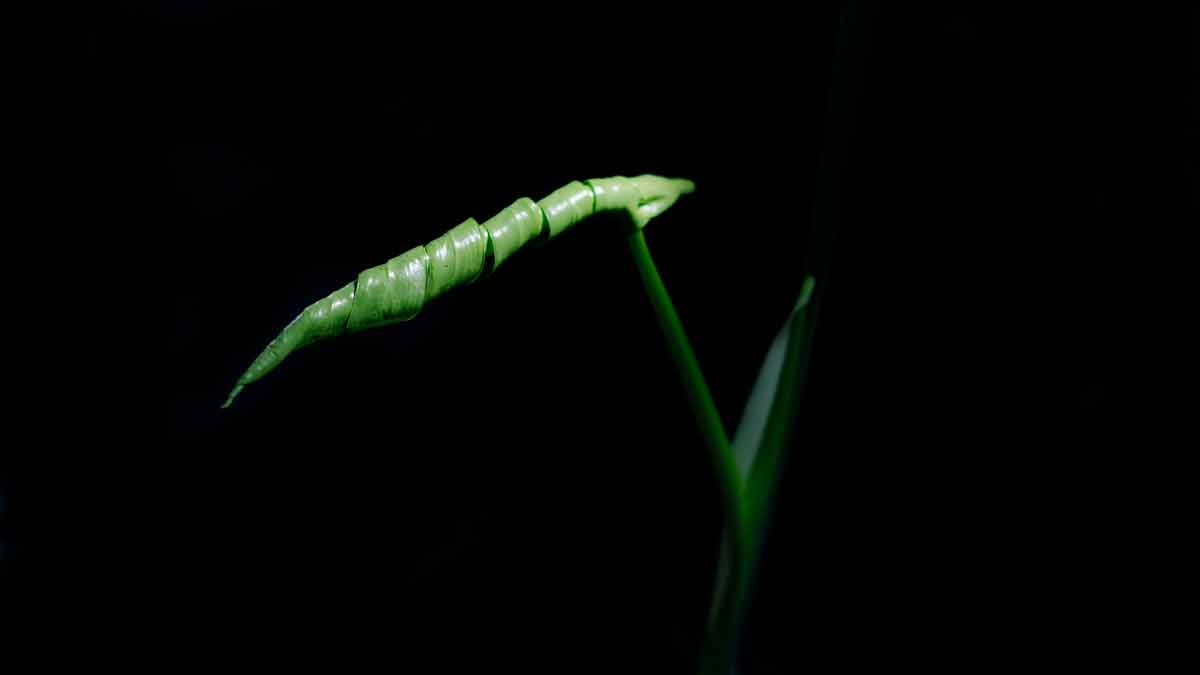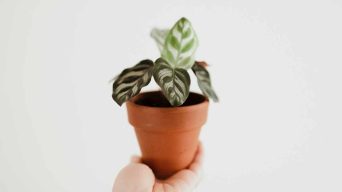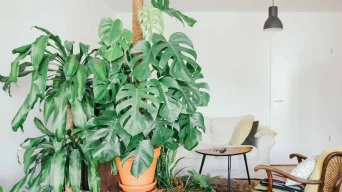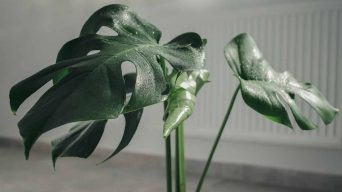Monstera plants can grow 1-2 feet per year with adequate light, moisture, and temperature. Growth rates vary by species, and they spread wide instead of tall. Providing more light can make it grow faster.
Are you curious about the growth rate of the stunning Monstera plant and how to maximize its potential indoors? Look no further!
This article will delve into the factors that affect Monstera’s growth, providing insightful tips on creating ideal growing conditions and overcoming common challenges.
So let’s unlock the secrets behind this tropical beauty’s impressive growth and transform your indoor garden into a lush paradise by continuing through our comprehensive guide.
Understanding Monstera Growth Rates
To gain insights into Monstera’s growth rates, it is crucial to delve into the factors that influence their growth, including the optimal growing conditions, growth stages, and other factors that can impact the growth rate.
Monstera plants are beloved for their unique foliage, and understanding how they grow can help gardeners cultivate healthier and more vibrant specimens.
Ideal Growing Conditions
To achieve optimal growth for your Monstera plant indoors, it is crucial to provide an environment that mimics its natural habitat in tropical rainforests.
These plants thrive in well-draining soil with a rich, organic composition.
You can use a combination of potting mix with peat moss and perlite or orchid bark to create the ideal soil blend for your Monstera.
This will ensure proper drainage while retaining enough moisture for healthy root development.
Light exposure plays a significant role in promoting vigorous growth for Monsteras.
They flourish under bright indirect light and can tolerate lower light levels but might not grow as fast or have their signature fenestrations on new leaves under low lighting conditions.
Too much direct sunlight, however, may scorch their delicate leaves, causing burn spots or stunted growth.
To avoid this issue, consider placing your plant near an east-facing window with ample morning sunlight before being shaded during the hotter afternoon hours.
Alternatively, you can use sheer curtains or blinds to filter intense midday sun rays.
To recreate the humidity level found in tropical climates, maintaining indoor humidity levels between 60% – 80% is highly beneficial for Monstera plants.
Some ways to increase humidity around your plant include grouping it with other houseplants, using a humidifier, or setting up a water-filled tray nearby to promote evaporation into the surrounding air spaces of the plant’s foliage.
Proper watering and temperature regulation should also be considered when creating ideal growing conditions.
Always ensure that soil roots are moist but never soggy and maintain room temperatures above 65°F (18°C) without exposing them to cold drafts from open windows during colder seasons.
Growth Stages And Factors That Affect Growth Rate
Monstera plants go through five growth stages that are crucial to their development.
These stages include seed germination, vegetative growth, the pre-mature stage with newly formed aerial roots, and the active mature stage, where leaves start producing the characteristic fenestrations or holes in their leaves and reaching maximum indoor size.
Understanding these growth stages can help plant enthusiasts provide tailored care to ensure optimal progress at each phase.
Various factors impact how fast Monstera grows, including light exposure, temperature, humidity levels, soil quality, moisture content, and proper potting techniques.
In ideal conditions – bright indirect light with good air circulation and moderate humidity – Monstera deliciosa can put out an average of 1 new leaf per monthly growth point.
However, inadequate care practices like insufficient lighting or overwatering may lead to stunted growth or health problems like root rot.
For example, placing your Monstera plant near a window facing east would give it enough sunlight while preventing direct sun exposure, which could cause scorched or yellowed leaves.
Indoor plant growers must create the right environment for their Monsteras by catering to their needs at each life cycle step.
Understanding these requirements and tailoring proper maintenance techniques such as pruning and providing appropriate support like moss poles for climbing during the mature stage.
Average Growth Rate Of Monstera Plants
Monstera plants are known for their lush foliage and unique leaf patterns.
Understanding the average growth rate of these plants helps you create the ideal conditions for them to thrive.
On average, Monstera plants can grow up to three feet per year when grown under optimal conditions indoors.
However, light intensity, temperature, and humidity can significantly affect their growth rate.
The size and age of your Monstera will also determine its growth rate.
Younger plants grow faster than mature ones as they have more energy reserves for new leaf production.
The location of your plant is equally important since adequate ventilation will prevent fungal infections that could slow down its growth rate.
By providing consistent care while factoring in all the variables mentioned above, you can expect a healthy Monstera plant with impressive growth rates!
Enhancing Monstera Growth
If you’re looking to enhance the growth of your Monstera plants, there are several key factors to consider.
Choosing the right pot and soil mix, proper watering and fertilization, optimal light exposure, and maintaining suitable temperature and humidity levels are all essential for promoting healthy growth.
Here, we’ll explore each of these factors in more detail and provide practical tips for enhancing the growth of your Monstera plants.
Choosing The Right Pot And Soil Mix
Choosing the right pot and soil mix is crucial for optimizing Monstera growth.
Here are some tips to consider:
- Pot size: Choose a pot one size larger than the current one, typically 2-4 inches larger in diameter.
- Drainage: Ensure your pot has drainage holes to prevent overwatering and root rot.
- Soil type: Use a well-draining soil mix that retains moisture without becoming waterlogged. A mixture of peat moss, perlite, and coarse sand can be ideal for Monstera plants.
- Perlite: Consider adding perlite to improve drainage and airflow within the soil.
- Moss pole: To support your Monstera’s climbing habit with a moss pole, ensure it’s inserted into the soil at planting time to avoid damaging roots later on.
Proper Watering And Fertilization
Proper watering and fertilization are crucial for the growth rate and overall health of Monstera plants.
Here are some tips for optimal watering and fertilization:
- Water Monstera plants thoroughly, but allow the soil to dry out slightly between waterings. Overwatering can lead to root rot, harming or killing your plant.
- Use a high-quality potting mix that is well-draining but retains moisture, such as a mix that contains peat moss, perlite, and vermiculite.
- Feed your Monstera with a balanced liquid fertilizer every two weeks during the growing season (spring through summer) when they are actively growing. A popular option is 20-20-20 fertilizer diluted to half strength. Be sure not to over-fertilize, as it can burn the roots and cause harm.
- Reduce fertilizing in the Winter months when plant growth slows down to avoid overfeeding them.
Providing The Right Light Exposure
To grow properly, Monstera plants need the right amount of sunlight.
Direct sunlight can scorch their leaves, so finding a balance between sun exposure and shade is essential.
Indirect light that is bright but not too intense is best for Monsteras.
If you notice yellowing or wilting leaves on your plant, it may be a sign that it’s getting too much direct sunlight.
In their natural habitat, Monsteras grow under the right amount of light exposure to encourage leaf development and growth.
You can mimic this by placing your Monstera in an area with bright indirect light for at least six hours daily.
East-facing windows are often ideal as they receive ample morning sun without the intensity of afternoon rays.
If you live in a location with limited natural light, consider investing in a grow light designed for indoor plants.
These lights provide full-spectrum lighting that simulates natural daylight and can help improve your Monstera’s growth rate.
Temperature And Humidity Requirements
Monstera plants are tropical plants that require consistent and specific temperature and humidity levels for optimal growth.
The ideal temperature range for Monstera growth is between 68°F to 86°F, which means they can grow well in average room temperatures as long as they are not exposed to cold drafts or extreme heat.
However, if the temperature drops below 50°F or rises above 95°F, it can negatively impact their growth.
In terms of humidity, Monstera Deliciosa requires a relative humidity range of between 60-80% to thrive.
While they can still grow in lower humidity conditions ranging from 40-50%, they may suffer from stunted growth, brown tips on leaves, and failure to produce larger leaves over time.
To ensure your plant receives the proper moisture level, consider using a humidifier or placing a tray with pebbles filled with water near your Monstera plant.
Maintaining consistent light exposure along with optimal temperature and humidity levels will go a long way in enhancing Monstera growth.
Common Issues That Hinder Monstera Growth
If you own a monstera plant, you know how much it can brighten your home with its unique, tropical look.
However, specific issues can hinder your plant’s growth and even cause it to die if not addressed.
These issues include pest infestations, overwatering, root rot, and improper care and attention.
Here we will discuss common problems that can affect the growth of your Monstera and provide tips on how to prevent and overcome them so that you can enjoy a healthy, thriving plant.
Pest Infestations
It’s no secret that pests can wreak havoc on the growth and vitality of a monstera plant.
Spider mites, mealybugs, aphids, and scale insects are common bugs that may attract your Monstera.
Fortunately, there are steps you can take to prevent infestations from occurring in the first place.
One crucial step is regularly wiping down the leaves of your Monstera with a damp cloth or spray bottle filled with water to keep them clean and free from debris.
Another way to keep pests at bay is by promoting healthy soil conditions for your Monstera.
Avoid overwatering, as this creates an environment favorable for pests like fungus gnats to thrive in.
Consider using neem oil or other natural insecticides if necessary, but be sure not to use too much, as this may harm your plant more than help it.
Lastly, use companion planting techniques by adding beneficial plants around your Monstera, such as marigolds or lavender, that repel pests naturally without resorting to harsh chemicals.
Overwatering And Root Rot
Overwatering is a common problem that can hinder Monstera growth and cause root rot.
It’s essential to avoid overwatering, as it can lead to mushy soil and ultimately harm the plant.
Root rot is caused by overwatering, which deprives the roots of oxygen, leading to their decay.
As a result, you may notice yellowing leaves or an unpleasant odor from the soil.
To prevent root rot, ensure your Monstera’s pot has proper drainage holes and only water when the top inch of soil feels dry.
If your Monstera does develop root rot due to overwatering, don’t despair yet!
There are ways to save your plant if you act fast. Carefully remove the affected parts and trim any soft or blackened roots with clean shears.
Repot the plant in fresh soil with good drainage while being careful not to damage any healthy roots remaining.
Wait patiently for new growth as your Monstera recovers from its ordeal!
Lack Of Proper Care And Attention
One of the reasons why Monstera plants may not grow properly is due to a lack of proper care and attention.
Neglecting your plant can lead to several issues, including stunted growth and yellowing leaves.
It’s important to inspect your Monstera for signs of stress or disease regularly.
To ensure that your Monstera thrives, it’s essential to provide it with an adequate amount of water and light.
Overwatering can lead to root rot, while insufficient watering can cause the leaves to wilt and droop.
Also, pay attention to its placement in the room, as Monstera requires bright indirect light.
By giving your Monstera plant the appropriate level of care and nurturing it needs, you’ll enjoy elegant vines sprouting from its aerial roots coupled together with healthy-looking leaves that will give you years-long pleasure!
How To Make Monsteras Grow Faster
If you’re a Monstera enthusiast, you should know how to accelerate the growth of your beloved plant.
Luckily, several methods to achieve this goal include adjusting the light levels, using fertilizer, repotting, pruning, and adding humidity to the environment.
Here we will explore the tips and tricks to make your Monstera grow faster and healthier, helping you enjoy its lush and iconic foliage in no time.
Increase Light Levels
One of the most effective ways to make your Monstera grow faster is by increasing the light levels in their environment.
These tropical plants thrive in bright, indirect light, so finding a sunny spot that doesn’t receive direct sunlight is essential.
If you notice that your Monstera leaves are turning yellow or brown and dropping off, this could be a sign that they’re not getting enough light.
Investing in a grow light can be an excellent way to supplement natural light and boost growth.
It’s worth noting that finding the right balance of light is crucial – too much direct sunlight can scorch and damage the leaves of your Monstera plant.
Aim for around 6 hours of bright, indirect light daily for optimal growth rates.
In addition to proper lighting conditions, providing plenty of water and nutrients can also help speed up growth rates for Monstera plants.
Keep soil moist but not waterlogged by frequently checking if dry before watering again, as overwatering can lead to root rot which could negatively impact its growth rate.
Incorporating a high-quality fertilizer into your regular care routine every few weeks during the growing season will provide necessary nutrients too!
Use A Fertilizer
Fertilizers are essential for Monstera plants to grow faster and healthier.
When choosing a fertilizer, choose a water-soluble and balanced formula that includes micronutrients such as magnesium and zinc.
Avoid using slow-release fertilizers as they may cause root burn or stunted growth. Fertilize your Monstera once every two weeks during the growing season, usually in spring and summer.
Remember to follow the manufacturer’s instructions and dilute the fertilizer solution to avoid overfeeding your plant.
In addition, organic fertilizers such as compost tea or fish emulsion can also benefit your Monstera by providing natural nutrients that improve soil quality.
If you notice yellowing leaves or stunted growth, your plant is likely experiencing a nutrient deficiency, so you may need to adjust your fertilization routine accordingly.
Using a fertilizer can significantly boost the growth rate of your Monstera plant if applied correctly with proper watering habits and adequate light exposure.
Keep track of how quickly your Monstera grows after being fed a good quality fertilizer – you might be surprised at how fast it can flourish!
Consider Repotting
Repotting your Monstera plant can help it grow faster and healthier.
As these tropical plants are fast growers, they quickly outgrow their pots, leading to stunted growth and root-bound issues.
Repotting provides the much-needed space for the roots to spread out and absorb necessary nutrients from the soil.
When repotting, choose a pot 2-4 inches larger than its current size.
Use a high-quality soil mix that drains well and contains organic matter to provide enough air pockets for good root development.
Water thoroughly after transplanting, ensuring moist but not waterlogged soil.
Providing sufficient space for root expansion through repotting encourages healthy Monstera growth with larger leaves and faster developing aerial roots.
Repotting also allows you to inspect your plant’s roots properly for any damages or signs of diseases, such as rot, that may hinder proper growth over time.
Implement Proper Pruning Techniques
Proper pruning techniques are essential for maximizing the growth of your monstera plant. Here are some simple steps to follow:
- Use clean, sharp pruning shears to make cuts on the stem.
- Always cut just above a node (where a leaf emerges from the stem).
- Remove dead or yellowing leaves regularly to allow for new growth.
- Trim off any damaged or diseased plant parts immediately to prevent further spread.
- If you want your Monstera to grow taller, prune back any side shoots and encourage vertical growth by training it up a moss pole or other support structure.
- Finally, be patient! It can take several weeks or even months for your monstera plant to show noticeable growth after pruning, but with proper care and attention, it will reward you with lush foliage and healthy growth over time.
Consider A Humidifier
One way to increase the growth rate of your Monstera plant is to use a humidifier.
These tropical plants thrive in high humidity environments, and a lack of humidity can cause browning of the leaves or slow growth.
A humidifier can help maintain ideal moisture levels for your Monstera, especially during dry seasons or in homes with low natural humidity.
Adding a humidifier to your indoor garden setup can improve plant health and encourage faster growth.
Aim for around 60-70% humidity for optimal conditions, and regularly check the water level in your humidifier to prevent it from running out.
With consistent care and attention, you should quickly start seeing new growth on your Monstera plant!
Remember that while using a humidifier can certainly aid in promoting fast growth, it’s important not to overdo it – excessive moisture can lead to root rot or fungal diseases.
Strike a balance by monitoring soil moisture levels and ambient air conditions through regular observation and adjustment.
Final Thoughts
Monstera plants are great additions to any indoor garden.
Their unique and beautiful leaves make them a favorite among plant enthusiasts.
Understanding their growth rate is essential for providing the care they need to flourish.
You can enhance their growth rate by providing ideal growing conditions such as the right pot and soil mix, proper watering and fertilization, light exposure, temperature, and humidity requirements.
Watch for common issues like pest infestations or overwatering hindering their growth.
With some extra care and attention using techniques like increasing light levels or considering repotting with fresh soil mix, your Monstera will grow at amazing speeds!







